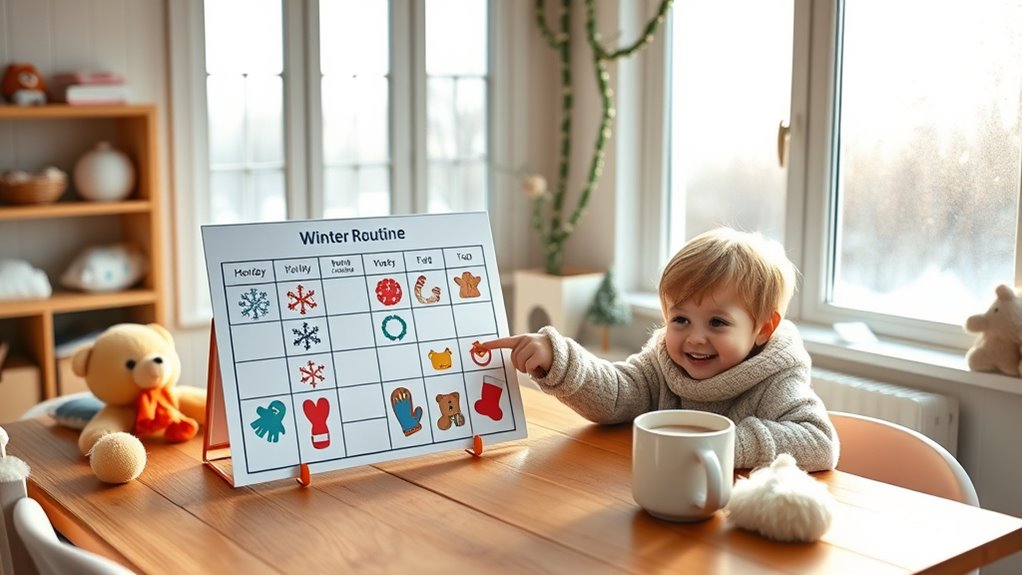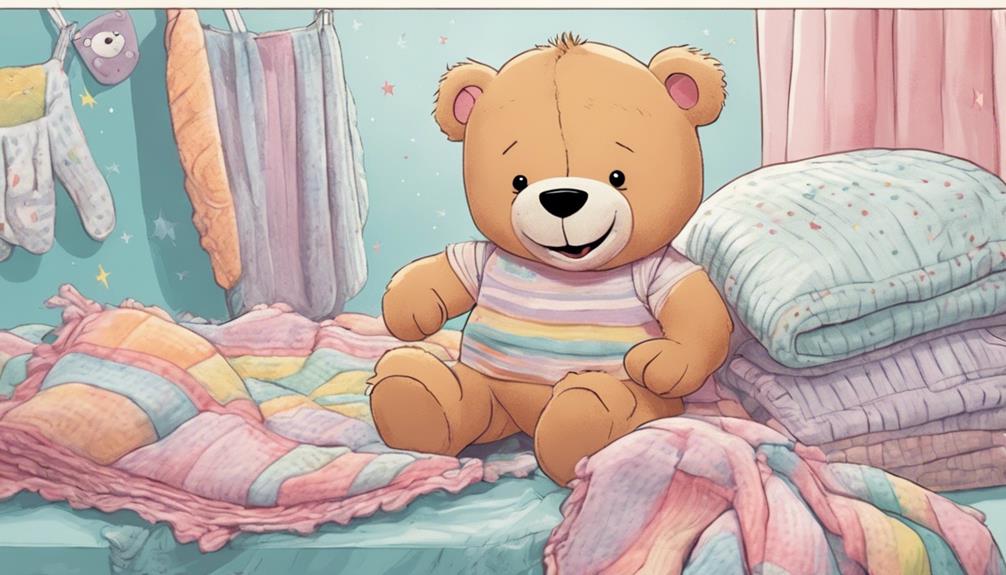To set up a winter routine chart for your kids, start by listing essential morning and indoor activities like dressing, eating, and brushing teeth. Use pictures or icons to make it visually appealing and place the chart somewhere visible. Involve your children in customizing it with their favorite colors and stickers. Stick to the routine consistently, praise their efforts, and add fun incentives. If you keep reading, you’ll discover simple ways to make winter days easier and more enjoyable.
Key Takeaways
- List essential morning and indoor winter activities with clear pictures or icons for visual understanding.
- Place the routine chart in a central, visible spot like the kitchen or mudroom for easy access.
- Involve children in customizing the chart with colors, stickers, and icons to boost engagement.
- Use consistent routines each morning and praise efforts to reinforce independence and good habits.
- Add fun incentives or rewards to motivate children and make following the routine enjoyable.

Are you looking for a simple way to keep your kids organized during the chilly months? Creating a winter routine chart can be just what you need to bring structure and fun into those cold days. When the weather keeps everyone indoors, it’s easy for routines to become chaotic, but a visual chart helps children understand what to expect and stay on track. Focus on their morning routines first—getting dressed, breakfast, and preparing for the day—so that everyone starts the day smoothly despite the gloomy weather outside. A clear, colorful chart can turn a hectic morning into an organized, stress-free start, giving your kids a sense of independence and accomplishment.
To set up an effective winter routine chart, start by listing all the essential activities your kids need to do each morning. Incorporate indoor activities that keep them engaged and active, like dressing in layers, brushing teeth, and packing their school bags or activity materials. Make the chart visually appealing—use pictures or icons for each task so younger children can understand without reading. Placing the chart in a central spot, like the kitchen or mudroom, ensures it’s visible and accessible, so your kids can check it off as they complete each step. This not only boosts their confidence but also builds good habits.
Next, involve your children in creating the chart. Letting them choose their favorite colors, stickers, or icons makes the routine more appealing and personalized. When kids have a say in their schedule, they’re more motivated to follow it. Be consistent in using the chart every morning; praise their efforts when they complete tasks independently. If they’re struggling with certain parts of the routine, adjust the chart to better suit their needs, whether that means breaking tasks into smaller steps or adding fun incentives like stickers or small rewards. Additionally, understanding the subconscious power during sleep can help reinforce positive routines and habits that support their well-being.
As winter progresses, you can expand the chart to include indoor activities for afternoons or evenings, such as reading, arts and crafts, or family games. This helps fill the day with purposeful, enjoyable activities that keep your kids occupied and off screens. The routine chart becomes a tool to foster independence, responsibility, and a sense of calm during the busy winter months. With patience and consistency, your children will learn to manage their mornings and indoor activities more confidently, making winter days more manageable and even enjoyable for everyone.
Frequently Asked Questions
How Can I Make the Routine Chart More Engaging for My Kids?
To make the routine chart more engaging, add colorful visuals that catch your kids’ attention. Incorporate interactive rewards like stickers or tokens to motivate them. Let your kids help design the chart, choosing their favorite colors and icons. Use fun characters or themes to make it lively. By making it visually appealing and interactive, you’ll encourage your kids to follow their routine happily and stay motivated throughout winter.
What Materials Are Best for Creating a Winter Routine Chart?
Think of your winter routine chart as a cozy snow globe, capturing the magic of the season. You’ll want to use durable materials like laminated printable templates to withstand daily use, and add fun winter-themed stickers to make it inviting. These materials are practical and engaging, helping your kids stay motivated. With the right supplies, your routine becomes a delightful part of their winter days, easy to update and keep fresh.
How Do I Handle Non-Compliance With the Chart?
To handle non-compliance with the chart, focus on behavior management by calmly addressing the issue and understanding why your child isn’t following it. Use positive reinforcement to encourage better behavior, praising small successes and offering rewards for consistent effort. Avoid punishment, and instead, stay patient and consistent. This approach helps your child stay motivated and gradually builds good habits, making compliance more natural over time.
Should the Routine Be Flexible or Strict During Winter?
You should keep the routine flexible during winter to accommodate changes in weather and winter activities. This flexibility helps your child stay engaged without feeling pressured. Prioritize outdoor safety, like dressing warmly and monitoring weather conditions. Incorporate fun winter activities into the routine, but be ready to adapt if conditions aren’t ideal. A flexible approach encourages cooperation and keeps your child safe and active during the colder months.
How Often Should I Update or Revise the Routine Chart?
Think of your routine chart as a garden that needs regular tending. You should review and revise it every few weeks, especially during seasonal changes. Routine review permits you to make seasonal adjustments, accommodating your child’s evolving needs and weather shifts. Keeping the chart fresh and relevant ensures your child stays engaged and adaptable, making the winter season smoother and more enjoyable for everyone.
Conclusion
By creating a winter routine chart, you’re planting seeds of consistency that will bloom into a season of growth and joy for your kids. With clear expectations and gentle guidance, you’ll help them navigate the colder months smoothly, turning routine into a comforting rhythm. Remember, a well-structured plan is like a sturdy bridge—connecting daily activities with warmth and security, making winter a time of happy memories and cozy moments for your little ones.









